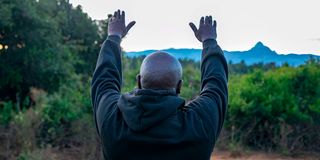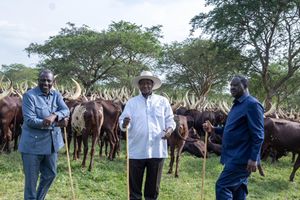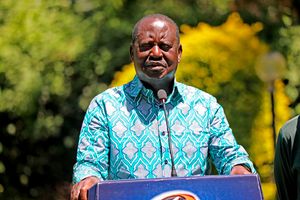
Deputy President Rigathi Gachagua at Mawingu Trail on the slopes of Mt Kenya on March 18, 2023.
When Moses Kuria called for a review of the National Dialogue Committee report, which led to a truce between President William Ruto and opposition leader Raila Odinga, his fears were pegged to the history of betrayal that has always shaped Mt Kenya politics.
Kuria had, among other issues, called for the inclusion of a one-man, one-shilling formula in the distribution of resources – an agenda that was part of President Uhuru Kenyatta’s Building Bridges Initiative. Kuria also demanded guaranteed minimum returns on cash crops.
The discomfort in the region and a feeling of déjà vu is borne of recent events. First, the image of Dr Ruto and Mr Odinga visiting President Yoweri Museveni’s Rwakitura home and the body language sent political shivers to those who had constructed Mt Kenya politics around an Odinga-phobia. This friendship paranoia is made worse by the ongoing campaign by Ruto and his Foreign Minister, Musalia Mudavadi, to have Odinga take over the African Union Commission chairmanship next year. More so, the anti-Odinga campaigns within the UDA zones of Rift Valley and Western have died out – leaving the Mt Kenya region without a political agenda.
Last year, Deputy President Rigathi Gachagua, who stands to lose in the latest shifts, had vowed to ensure that Odinga never meets President Ruto. His “nimeweka mitego kila mahali” (I have put traps everywhere) was intended to make it impossible for Ruto to shift loyalty to Raila, who has mastered the art of political survival over the years. Restlessness in the Mt Kenya region – perhaps over the “handshake” between Dr Ruto and Raila – was seen in a meeting attended by the DP, in which Mbeere North MP Geoffrey Ruku said the region would face “man-to-man” those who disrespect Gachagua following the Odinga truce. At the same time, two legislators in Kandara and Gatanga rallied their constituents to oppose a bid to tax avocado farm produce. During the meeting, they alleged that only cash crops from Mt Kenya region were getting taxed.
UDA constitution
The place of Gachagua as Dr Ruto’s running-mate in the 2027 presidential race appeared to be in doubt after the President called for a revision of the UDA constitution to guarantee a male-female candidate. If that happens, Gachagua’s position will be compromised – and might be short-changed the way President Moi did to his Vice President, George Saitoti. Interestingly, Dr Ruto claimed they had agreed with Gachagua over that, which puts the DP in an awkward political space for he cannot contradict the president.
Nyeri Senator, Wahome Wamatinga, a long-time ally of the deputy president, has been calling for the formation of a Mt Kenya party to champion the region’s interests within Kenya Kwanza. Whether they feel like outsiders in the most populous party is unclear, but an attempt to hold grassroots elections in December 2023 flopped, and they were rescheduled to April 2024. If they happen, the elections will test the popularity of the elected leaders in party politics. More so, a push by the Gachagua camp to have Mudavadi and Moses Wetang’ula dissolve their parties appears to have died out.
Dismantling Gema
History appears to be repeating itself, and for Mt Kenya politicos, the script is from the 1980s. Before he came to power in 1978, President Moi had relied on the support of Attorney-General Charles Njonjo and Mwai Kibaki to protect him against the powerful Gikuyu, Embu, and Meru Association, which had started the Change-the-Constitution debate in 1977 to stop Moi from succeeding Kenyatta. Though the discussion was stopped, it left a big divide in Kenyan politics.
After getting power, and with the help of Njonjo, Moi started dismantling Gema’s political and economic might. On January 25, 1979, top Gema officials were taken to court for failing to file the company’s annual report. Among those in court included chairman and nominated MP Njenga Karume, his deputy Duncan Ndegwa (then Governor of Central Bank), and the Gema national organising secretary, Kihika Kimani.
As the then-US Ambassador Le Melle wrote in a famous cable to the Bureau of African Affairs at the State Department, “the days of Kikuyu privilege are over”. He observed that “The full list of those taken to court read like “Who’s Who” of top echelon Kikuyu politicians. (Such) court summons and subsequent fines would have been unthinkable during Kenyatta’s day.” President Moi shaped Mt Kenya politics by dropping all the prominent personalities in the region. Those targeted first were the likes of Mbiyu Koinange, Dr Julius Gikonyo Kiano, and Dr Njoroge Mungai who had exhibited presidential ambitions – and Moi was comfortable working with newcomers as he plotted to drop both Njonjo and Kibaki, later.
Njonjo’s fall was the most choreographed political event in Kenya. Depicted as a “traitor”, he was regarded as aloof and to re-organise the national politics, Moi in 1984 dissolved Parliament in which all the perceived Njonjo sympathisers, real and imagined, were rigged out. More so, Njonjo was taken through the humiliating Commission of Inquiry, which found him “guilty” of various offenses. Interestingly, Odinga, then in detention, was brought to crucify Njonjo and led credence to an accusation that the AG had also planned to topple President Moi.
Njonjo was demonised, in the same style as President Uhuru Kenyatta, to pave the way for weak political candidates from the region. While the fall of Njonjo would have strengthened Kibaki’s position as Vice President, it led to his isolation to the extent that by 1988, he was dropped as VP. Moi went for an upstart, Dr Josephat Njuguna Karanja, whose short tenure ended in controversy. His own Mt Kenya politicians accused him of being a “kneel-before-me” politician.
The current discomfort in Mt Kenya is informed by the pick-use-and-drop politics of yesteryears and the history of betrayal that also saw Saitoti, the Maasai with Kikuyu heritage, fall off after many years as Moi’s deputy. Saitoti’s fall was occasioned by the entry of Raila into Kanu. During the March 18, 2002 merger of Kanu and Raila’s National Development Party at Kasarani, Gymnasium Stadium, Saitoti found out that his name was not in the new line-up that had been crafted to accommodate Odinga’s entry.
As VP, Saitoti had campaigned for the merger only to realise at the last hour that he was not one of the four vice-chairmen set for the election. It was a dramatic fall, and he complained loudly to President Moi. It was the first time that many of his friends saw him complain bitterly. But Moi dismissed him: “Professor, if your name is not on the list, it is not there.”
It was then that he took the microphone: “I know there are many of you who wanted me to contest, is that not so? (But) there comes a time when the nation comes before the individual… but one day I will be proved right.” How Odinga’s latest rehabilitation within the framework of UDA will affect Mt Kenya politics remains to be seen. But what is certain is that both Azimio and Kenya Kwanza politics will be jolted by Raila’s camaraderie with President Ruto. If there is a shift in national politics, Mt Kenya will play outside the circle – thanks to the Odinga phobia it has cultivated since the Jomo Kenyatta days.
The man on the spot will undoubtedly be Gachagua, who has to watch his space. Like a man in a quagmire, he has little space to struggle since not all Mt Kenya political elites like him. His space is also threatened by the likes of Kiharu MP Ndindi Nyoro and Kikuyu’s Kimani Ichung’wah.
Again, Gachagua was not the most favourite running-mate within Kenya Kwanza – and Dr Ruto knows that. If UDA supporters in Mt Kenya ever dreamt of a Gachagua presidency, that could be a long shot. The National Dialogue Committee report has proposed to formalise the position of Mudavadi and that could also destabilise Gachagua’s position. If Ruto’s promise to have a woman running-mate materialises, then the post-Ruto race will be an open field.
At the moment, the Mount Kenya region is caught between a rock and a hard place.







